
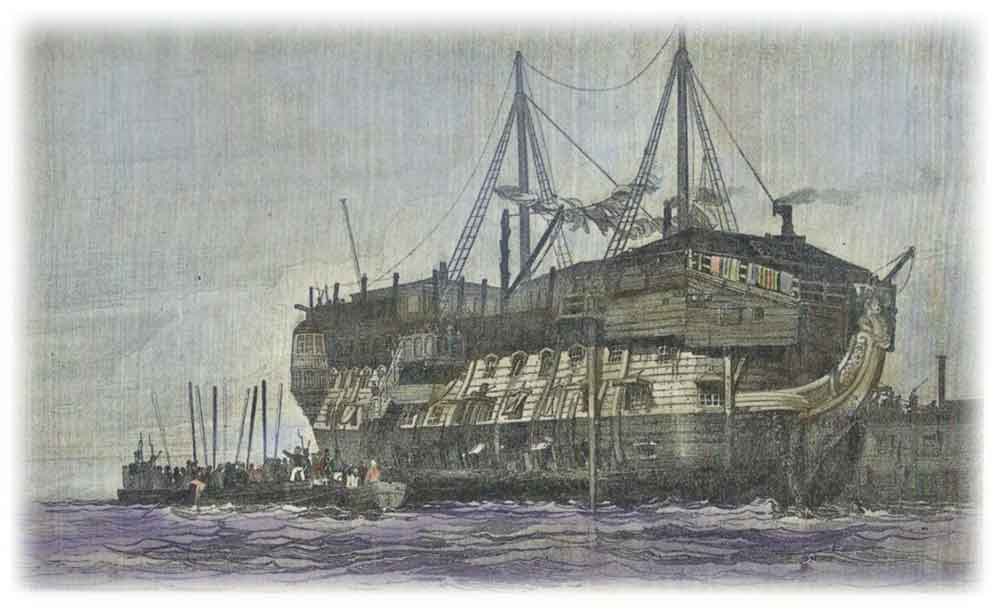
The Prison Hulk York , in Portsmouth Harbour
Transportation – the movement of prisoners to another jurisdiction, to serve their sentence under hard labour, had been part of British policy since Elizabethan times. During the Cromwellian era, transportation to the West Indies and America was used as a means of removing undesirables . In the 18th Century, America became the preferred destination for the transportation of convicts, until American independence removed this option.
In Georgian Britain, the rise of the Industrial Revolution had brought about massive demographic change, and the expansion of the populations of the cities of the British Isles. The corresponding rise in crime began to concern those in power, with the rise in the belief of the 'Criminal Class'. The Death Penalty, which was in force for the most trivial of crimes, was seen as too harsh, and a better way was needed. The solution, transportation, was seen as removing the problem- the criminals, to the newly discovered continent of Australia.
In Ireland, the authorities used transportation in an attempt to also crush the agrarian uprisings by groups such as the Whiteboys and Terry-Alts, using the Insurrection Act.
Beginning in the 1780’s, transportation was implemented on a massive scale, and lasted until 1868. In that time it is estimated that over 160,000 convicts were transported to the Australian Continent
In Ireland, transportation to Australia began in 1791. The first convict ship to sail from Cork was the Queen , in September 1791. Initially convicted prisoners, were held in City and County Gaols, throughout the country. Arrangements were then made to bring them to ports such as Dublin and Cork to be shipped out in prison ships.
This was extremely inefficient, and open to massive abuses by members of local authorities who controlled these gaols. There were also massive delays with convicts languishing for months on prison ships while the human cargo was gathered. This also lined the pockets of the contractors to this trade. An investigation into Cork City Gaol, at the North Gate Bridge, in 1817, exposed the rampant corruption, and a new process for incarceration prior to transportation was needed.

18th Century View of the North Gate Bridge and Old City Gaol, by Nathaniel Grogan

Modern view of the area around the Nortgate bridge
In 1817 the Convict Depot was set up in Elizabeth Fort, in Cork City. Elizabeth Fort had been the main military barracks in Cork until the building of the ‘New Barracks’ on the northside of Cork, which became Victoria Barracks (Collins Barracks). Initially this convict depot was for men and women, but quickly, it became apparent that it could not cope with the numbers of convicts. Newgate and Kilmainham in Dublin served as convict holding depots for the Dublin and Northern region, but were criticised as being out of date and unable to cope with expected numbers.
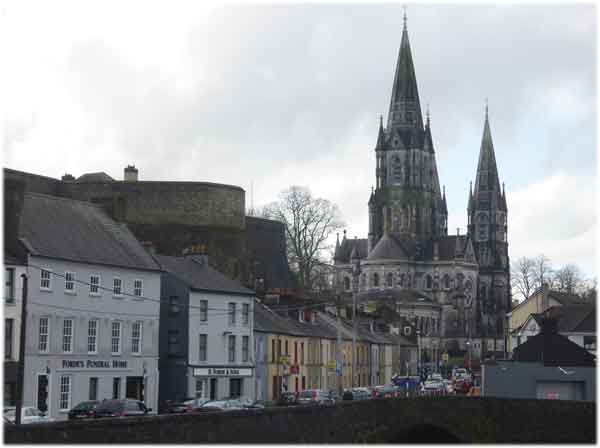
Elizabeth fort, in Cork City
The idea for a prison hulk at Cork was attributed to a suggestion to the Navy Board in 1819 by Lieut Lewis, RN Transport agent at Cove.By 1822 It was decided to install convict hulks in Cork Harbour and Kingstown Harbour (Dun Laoghaire). Prison Hulks were, as the name suggests, wooden warships, at the end of their useful life, that had all their means of propulsion, and armament removed and became static floating receptacles. In this case for the holding of prisoners. They usually consisted of a hull with lower masts standing , with a covering or awning over the main deck. Depending on the class of ship there were either two or three levels of decks for holding the prisoners. Rudimentary washrooms were built overhanging the bow area. They were a fearsome destination, with the inmates manacled at legs and hands for almost all of their time aboard. Ailments such as Scrofula and Tuberculosis were rife onboard these hulks.
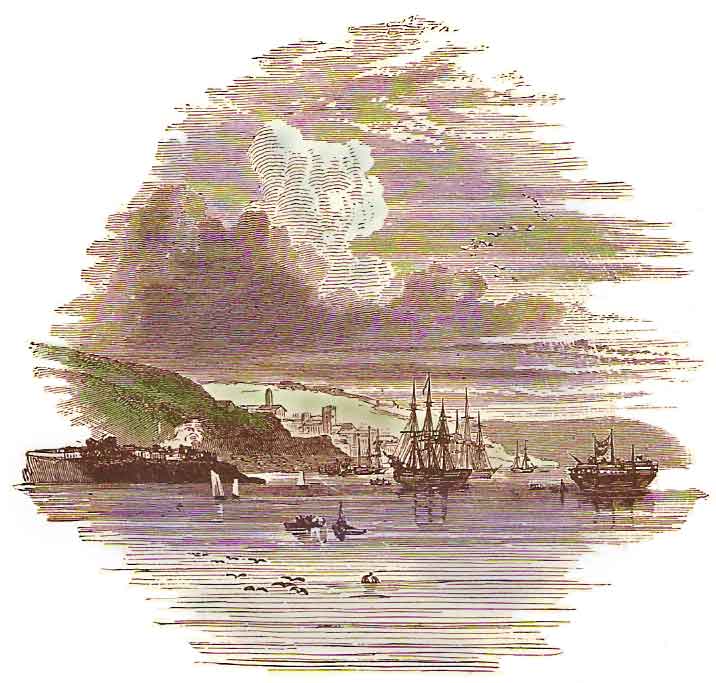
This 19th Century image of a hulk in Cork Harbour, may or may not be that of the Surprise
In May 1823 The Hulk HMS Surprise was installed in Cork Harbour, for the holding of male convicts prior to transportation. In 1824 the Hulk HMS Essex was brought to Kingstown (Dun Laoghaire) for the same purpose. HMS Surprise (1812) was a 38 gun Leda-class frigate, which had been hulked at Milford Haven by 1822. She was prepared at Plymouth as a prison hulk and towed to Cork in 1823. She was moored in Monkstown Bay, close to the Oyster Bank, and approximately half a mile from White Point on Great Island
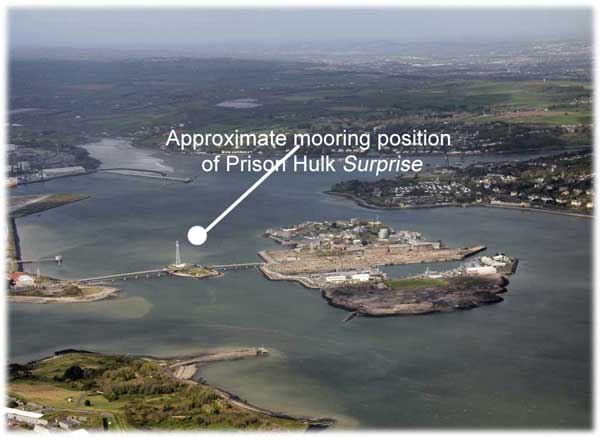
a modern image of the approximate location of the Surprise
The Hulk Surprise , received its first 37 inmates in May 1823, they were mainly convicts from the recent Kerry assizes. One hundred more men were transferred on board from the Cork depot in June. On the 1st of July the first escape was made from the Surprise , when convict Timothy Roirdan jumped over the side during a torrential thunderstorm. He had gotten his leg irons removed due to ulcerated legs and was working on deck, when he saw his opportunity to flee. He swam to White Point and made his escape. He was recaptured a few days later near the New Barracks in Cork City.
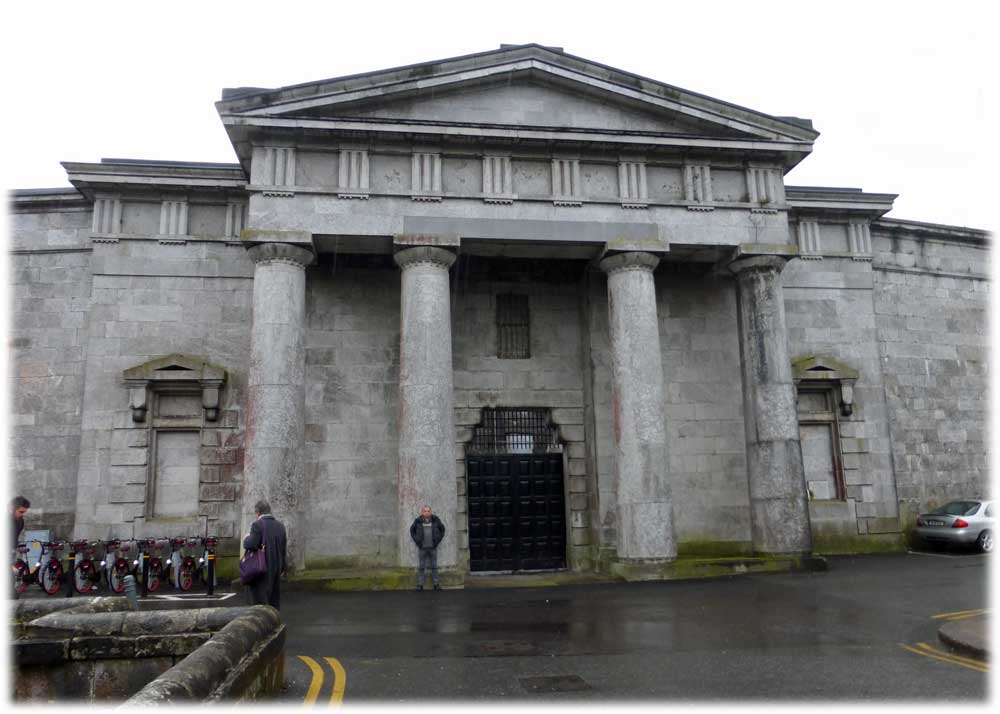
Views of the old County Gaol site (South Gate Bridge) and undernath, the facade of the New County Gaol (Western Road)
By July 1823, there were over six hundred convicts between the Surprise and Cork Depot. In August the first prisoners were transferred to the prison transports Isabella, Medina, and Castle Forbes which left for Australia. This ship arrived in January 1824.
For the years 1823 and 1824 convicts from all over Ireland were brought to Cork with the males incarcerated in the Surprise and females in the Convict Depot, until the respective transports arrived to take them to New South Wales. The carriage of prisoners from various regions to Cork for transportation varied. They included intermediate ships contracted to take them from the Pigeon House dock in Dublin, to jaunting cars and horse carts from towns such as Clonmel. Frequently convicts were marched many miles escorted by militias or soldiers.
From 1825, with the commissioning of the Essex , convicts mainly from the southern and western regions of the country were brought to Cork. Convicts were still shipped from Dublin to Cork, for onward transportation to Australia.
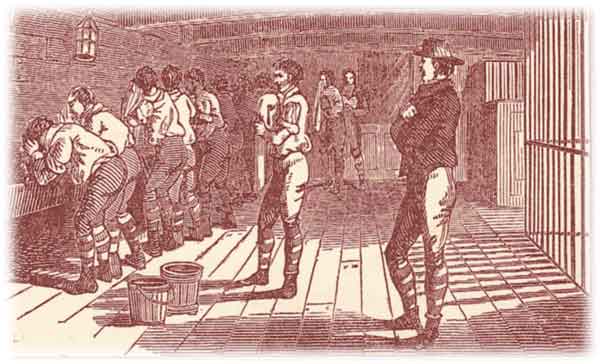
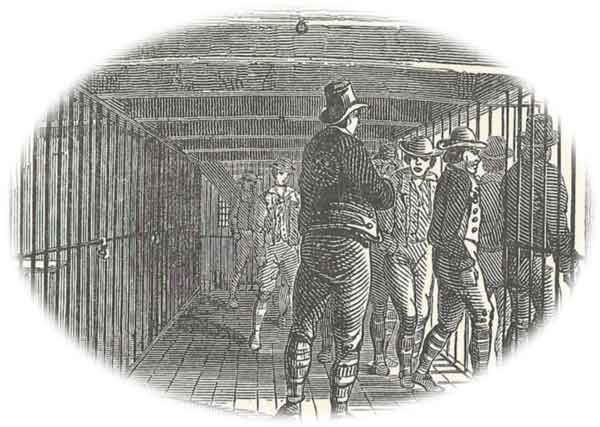
images from the Illustrated London News, on board a prison hulk, The reality was far more squalid
In July 1824, prisoners attempted to set fire to part of the Surprise . The alarm was quickly raised,and Captain Ribouleau , and some of the crew of HMS Semeramis the Guard Ship at Cove, managed to extinguish it.
The Report of the Inspectors General on the General State of the Prisons of Ireland 1825, lamented the fact that because the Surprise was not tethered to the shore, convicts could not be used for Government works. It was suggested that Spike Island should be used as a convict penitentiary, with the convicts used in the construction of the fortifications.
Spike island had been used for temporary incarceration of prisoners during the Cromwellian wars. At this time this advice was not acted upon. While on board there was limited employment among the convicts. This consisted of picking oakum, tailoring, shoemaking and net making. There was very limited schooling, administered by convicts considered qualified. There were no teachers assigned to the Surprise .
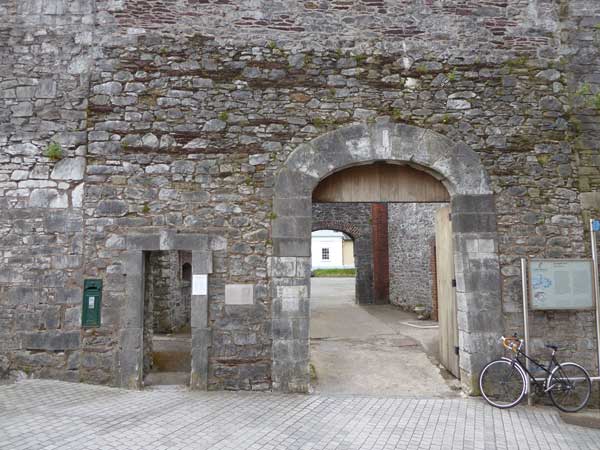
The entrance to Elizabeth Fort, the Female Convict Penitentiary in Cork
In April 1827 the noted prison reformer Mrs Fry, visited the hulk Surprise . In her report addressed to the Marquess Wellesley, Lord Lieutenant of Ireland, she stated that “When we were in Cork we inspected the prison used as a depot for female convicts previous to transportation, and we also visited the Hulk Surprise , used for Male prisoners under similar circumstances. The former (Elizabeth Fort) is defective as to its conformation, but both appeared to us to be cleanly, comfortable, and well superintended”.

The Cork Penitentiary diet
In August 1828, there was a pitched battle between convicts on board the Surprise . The only weapons available to the convicts were their shoes, with which they managed to effect some injuries on one another before being subdued by the Superintendent and his assistants. In July 1834 a prisoner Whelan succeeded in escaping from the Surprise , but five days later he was apprehended in Galway and returned on board.
In late July two more prisoners jumped overboard and attempted to swim to White Point. One made it to shore and made good his escape, while the other was recaptured and brought on board the Surprise . This convict showed some desperation by slipping his guards and again leaping overboard, only to be recaptured again.
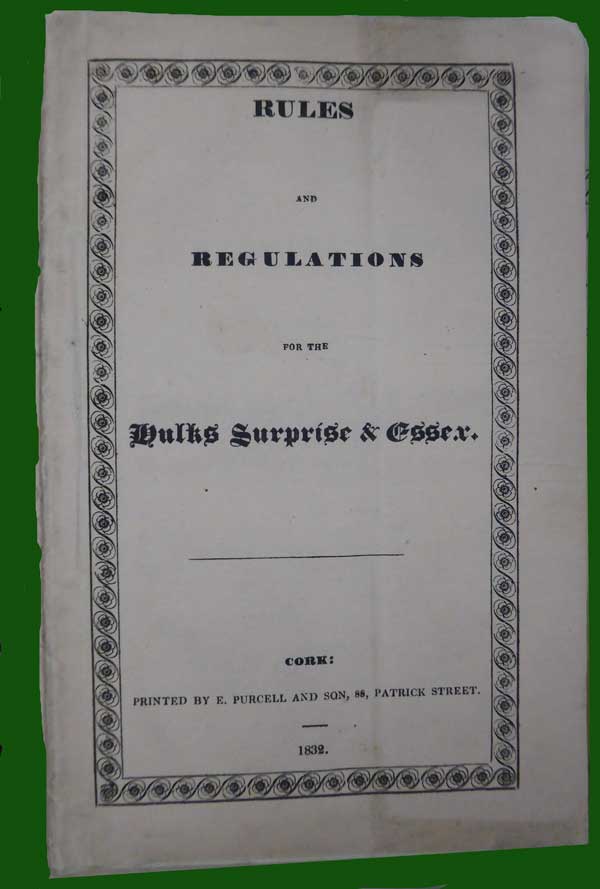
Set of Printed Rules of those incarcarated on board the Surprise and the Essex
On the 24th of March 1835, another attempt was made to set fire to the Surprise . Three separate fires were found on board the ship, which were quickly put out.
In August 1835, faction fighting broke out between the inmates of the Surprise , who armed themselves with rudimentary weapons fashioned from metal barrel hoops. It was quickly suppressed.
In March 1836 it was announced that the hulks at Cove and Kingstown were to cease to be used for convicts. There were a number of reasons, mainly that the Hulks had ended their useful life, and costs were far in excess of land-based incarceration. In September 1836 the transport St Vincent , collected the final convicts from the hulks Essex and Surprise for conveying to New South Wales.
By December the Prison Depot at Elizabeth Fort was closed, and male and female convicts were then housed at the new City Gaol, before being sent to Dublin, from where they were transported.
In January 1837 the contents of the Surprise and the Convict depot were sold locally, and in June 1837. The
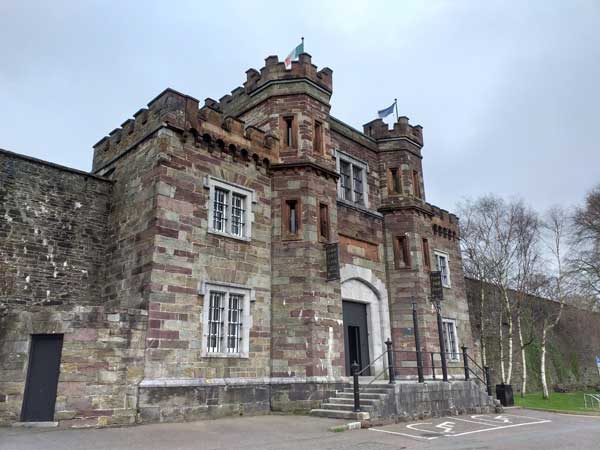
The new City Gaol, which replaced the one at the North Gate Bridge
Spike Island eventually became Ireland’s major Convict Depot from 1847 to 1883.
